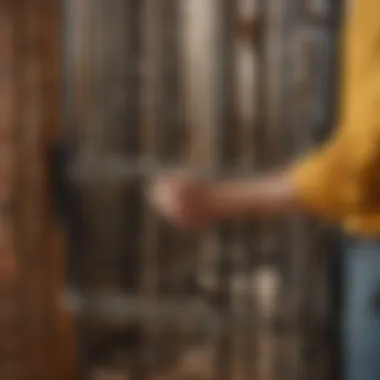Materials:
- 6-foot chain link gate
- Galvanized steel posts (4 inches in diameter)
- Concrete mix
- Gravel
- Gate hardware kit (includes hinges, latch, and screws)
DIY Steps:
-
Preparation: Start by measuring the area where the gate will be installed to ensure it fits properly. Mark the locations for the posts and dig holes accordingly, ensuring they are deep enough to support the gate securely.
-
Setting the Posts: Place the galvanized steel posts in the holes and use a level to ensure they are plumb. Mix the concrete and fill the holes around the posts, allowing it to set and cure completely.
-
Attaching the Gate: Install the gate hardware kit according to the manufacturer's instructions. Attach the hinges to one post and the latch to the other, ensuring the gate swings open and closes smoothly.
Technical Aspects:
-
Tools: You will need a post hole digger, level, concrete mixer, shovel, and wrench.
-
Timing Specifics: Allow ample time for the concrete to set and cure, typically 24-48 hours.
-
Critical Techniques: Ensure the posts are properly aligned and securely anchored in the concrete for long-lasting stability and durability.
DIY Project Process:


-
Measure and Plan: Accurate measurements and thoughtful planning are key to a successful installation.
-
Post Installation: Taking the time to set the posts correctly will determine the gate's overall stability.
-
Gate Assembly: Following the instructions provided in the hardware kit is crucial for proper function.
Troubleshooting Tips:


- If the gate doesn't close properly, adjust the hinges or latch for a better fit.
- In case of uneven swinging, check the alignment of the posts and adjust as needed for smooth operation.
Introduction


In the realm of home improvement projects, the installation of a 6-foot chain link gate holds paramount significance. This introductory section serves as the gateway to a comprehensive guide that delves into the intricacies of setting up a chain link gate. Understanding the nuances of this process can make all the difference between a sturdy, well-installed gate and a haphazardly put together one. As we embark on this journey, we will explore the importance of meticulous planning, precise measurement, and executing each step with care and attention to detail. Through this guide, both DIY enthusiasts and seasoned professionals will glean valuable insights that pave the way for a successful project completion.
Understanding Chain Link Gates
What is a Chain Link Gate?
At the core of any chain link fencing system sits the chain link gate - a crucial component that offers convenience, security, and durability. Prominent for its interwoven wire mesh design, a chain link gate provides a versatile solution for enclosing a wide array of properties, from residential homes to commercial establishments. The key characteristic of a chain link gate lies in its ability to strike a balance between functionality and cost-effectiveness. Its open weave structure allows for transparency while offering sufficient strength to withstand external forces. This makes it a popular choice for those seeking a balance between visibility and security. The unique feature of a chain link gate is its low maintenance requirements, making it a favored option for busy homeowners or property managers. While it may lack the ornate aesthetics of other gate types, its practicality and longevity are unparalleled, making it an ideal choice for various applications.
Benefits of Choosing a Chain Link Gate
Opting for a chain link gate boasts several benefits that cater to the practical needs of property owners. The durability of galvanized steel ensures that the gate can withstand harsh weather conditions without corroding or deteriorating rapidly. This resilience translates to long-term cost savings by negating frequent replacements or repairs. Additionally, the transparency of the chain link design grants visibility, allowing property owners to monitor activities outside their perimeter with ease. This feature is especially valuable for security purposes, offering a clear line of sight while maintaining a physical barrier. The quick and straightforward installation process further enhances the appeal of choosing a chain link gate, making it an accessible option for those looking to secure their property efficiently. Despite its utilitarian appearance, the chain link gate excels in functionality, providing a robust and reliable solution for property enclosure needs.
Pre-Installation Preparation
In the process of installing a 6-foot chain link gate, pre-installation preparation plays a crucial role in ensuring the overall success of the project. Proper preparation is essential to streamline the installation process and prevent potential issues down the line. It involves gathering all the necessary materials and tools, conducting a thorough site assessment, and accurate measurements.
Gathering Materials and Tools
Essential Materials:
When it comes to essential materials, selecting the right components is key to the gate's longevity and functionality. High-quality chain link fabric, sturdy gate posts, concrete for securing the posts, gate hinges, latch mechanisms, and tension bars are among the critical materials needed for a durable chain link gate. The chain link fabric is typically made of galvanized steel, providing durability and resistance to corrosion, ensuring longevity in various weather conditions. Choosing the correct gauge of chain link fabric is crucial, with heavier gauges offering enhanced strength and security for the gate.
Recommended Tools:
The selection of appropriate tools significantly impacts the ease and efficiency of gate installation. Essential tools include a post hole digger or auger for digging holes, a level for ensuring posts are upright, a tape measure for accurate measurements, a socket wrench set for fastening hardware, and a tension bar tool for stretching the chain link fabric. Additionally, having gloves, safety glasses, and a concrete-mixing tool for securing posts adds to a safer and more convenient installation process. Investing in high-quality tools not only ensures a smoother installation but also enhances the gate's overall stability and functionality.
Site Assessment and Measurement
Checking the Site:
Thoroughly examining the installation site is critical to identifying any potential obstacles or challenges that may impact the installation process. Clearing the area of debris, vegetation, or any obstructions ensures a clean and safe workspace for assembly. Checking the site also involves assessing the terrain for slopes, uneven ground, or potential drainage issues that may affect post placement or gate operation. By addressing these factors early on, you can prevent complications during installation and enhance the gate's structural integrity.
Measuring for Accuracy:
Accurate measurements are essential for ensuring that the gate fits correctly within the designated space. Using a tape measure, take precise measurements of the gate opening width and height to determine the required size of the chain link fabric and gate frame components. Additionally, measuring the distance between gate posts with precision guarantees the gate aligns correctly when installed. Accuracy in measurements is crucial for a seamless installation process and a professionally finished chain link gate.
Gate Installation Process
In the intricate process of installing a 6-foot chain link gate, the Gate Installation Process holds paramount significance. This section dives into the crucial steps involved in setting up the gate, ensuring its stability, functionality, and long-term durability.
Setting the Posts
Digging Holes
Digging Holes plays a pivotal role in the Gate Installation Process. The depth, circumference, and positioning of these holes are essential to support the gate structure adequately. By meticulously excavating the holes to specified measurements, we lay the foundation for a sturdy gate installation. The key characteristic of Digging Holes lies in creating a stable base for the gate's posts to firmly anchor into the ground. This meticulous approach ensures that the gate remains upright and withstands external forces. While time-consuming, the process of Digging Holes proves beneficial as it forms a robust foundation for the gate, contributing to its overall strength and longevity.
Installing and Leveling Posts
Installing and Leveling Posts further solidifies the gate framework. Placing the posts correctly in the dug holes ensures a straight and aligned structure. By meticulously leveling the posts, we guarantee that the gate will operate smoothly without any hindrances. The key characteristic of Installing and Leveling Posts lies in providing a balanced and secure structure for the gate frame. This step is crucial in preventing any leaning or misalignment of the gate, enhancing its overall functionality and aesthetic appeal. While time-intensive, this process is popular for its ability to create a reliable foundation for the gate, offering advantages such as increased gate stability and enhanced visual appeal.
Attaching the Gate Frame
In the Gate Installation Process, Attaching the Gate Frame involves securing the structure for optimal functionality and security.
Securing the Frame
The process of Securing the Frame ensures that the gate frame is firmly attached to the posts, preventing any wobbling or instability. The key characteristic of securing the frame lies in providing structural integrity to the gate, making it capable of withstanding external pressure and ensuring long-term durability. This method is popular for its ability to enhance the gate's overall strength and security. While time-consuming, this step proves beneficial in offering a reliable and robust attachment for the gate frame, securing its operational performance.
Ensuring Proper Alignment
Proper alignment is crucial for the gate to function seamlessly. Ensuring Proper Alignment guarantees that the gate frame is straight and aligns correctly with the posts. This step's key characteristic lies in optimizing the gate's operational efficiency by eliminating any alignment issues that may hinder its opening and closing mechanisms. This approach is popular for its precise adjustments, enhancing the gate's performance and minimizing the risk of malfunctions. While requiring attention to detail, this process offers advantages such as smooth gate operation and prolonged structural integrity.
Hanging the Chain Link Fabric
Another key phase in the Gate Installation Process is Hanging the Chain Link Fabric, which is instrumental in adding a security layer to the gate.
Attaching the Fabric
Attaching the Fabric involves securing the chain link material to the gate frame, providing a protective barrier. The key characteristic of Attaching the Fabric is its ability to enhance the gate's security and privacy, making it a popular choice for residential and commercial properties requiring controlled access. This method's unique feature lies in its versatility, offering customizable options for different security levels and aesthetic preferences. While demanding precision, this step proves beneficial by adding a durable and protective layer to the gate, enhancing its functionality and visual appeal.
Stretching and Securing
Stretching and Securing the chain link fabric ensures a taut and resilient barrier. By carefully stretching and securing the fabric to the frame, we eliminate sagging or weak points that could compromise the gate's security. The key characteristic of Stretching and Securing lies in providing a stable and reliable enclosure, offering peace of mind regarding property safety. This method is valued for its capacity to enhance the gate's security features and durability. Despite the meticulous nature of this step, it delivers advantages such as increased gate resilience and improved property protection.
This meticulous and detailed approach to the Gate Installation Process ensures a thorough and effective installation of a 6-foot chain link gate, meeting the highest standards of functionality, security, and longevity.
Fine-Tuning and Adjustments
Fine-tuning and adjustments are crucial elements in the installation of a 6-foot chain link gate. These final steps ensure that the gate functions properly and is secure for long-term use. Fine-tuning involves checking alignment and stability, making any necessary adjustments to guarantee the gate operates smoothly. Stability is key to the gate's durability, preventing potential misalignments or structural issues. Attention to detail during this stage enhances the gate's overall performance and longevity.
Checking Alignment and Stability
Ensuring Proper Alignment
Ensuring proper alignment is a fundamental aspect of gate installation. It involves the precise placement of components to ensure the gate opens and closes smoothly without any obstructions. Proper alignment is essential for the gate to function correctly, providing ease of use for homeowners. By aligning the gate accurately, potential issues such as sticking or uneven movement can be avoided. This meticulous process ensures that the gate fits seamlessly within the designated space, enhancing both the gate's aesthetics and functionality.
Securing Stability
Securing stability plays a vital role in the gate's long-term performance. This step involves securely anchoring the gate to prevent swaying or instability, especially in areas prone to strong winds or external forces. Stability ensures that the gate remains firm and upright, reducing wear and tear on the components. By securing stability through proper bracing and anchoring methods, the gate can withstand external pressures and maintain its structural integrity over time. This contributes to the gate's overall reliability and endurance in various weather conditions.
Adding Finishing Touches
After ensuring alignment and stability, adding finishing touches elevates the gate's overall appearance and protection. Final adjustments involve fine-tuning any last-minute details to perfect the gate installation. This includes checking hardware, mechanisms, and gate operation to address any potential issues and ensure smooth functionality. By meticulously reviewing all components, the gate can operate optimally without any hiccups, providing convenience for users.
Final Adjustments
Final adjustments encompass the fine-tuning of all components to guarantee seamless operation. This step involves tweaking hinges, latches, and other mechanisms to optimize the gate's movement. By making precise adjustments, any minor discrepancies in alignment or functionality can be rectified, enhancing the gate's performance. Attention to detail during final adjustments enhances the user experience and ensures that the gate functions flawlessly.
Applying Protective Coating
Applying a protective coating serves as a safeguard against environmental elements and corrosion. This final touch protects the gate from rust and deterioration, extending its lifespan and maintaining its appearance. The protective coating acts as a barrier, shielding the gate from moisture, sunlight, and other damaging factors. By applying a durable protective coating, homeowners can enjoy a visually appealing gate that withstands the test of time, requiring minimal maintenance and upkeep.
Conclusion
The conclusion of this ultimate guide signifies the crucial stage where all the hard work and meticulous planning culminate in a successfully installed 6-foot chain link gate. It serves as the final checkpoint to ensure that every detail has been carefully executed to guarantee the gate's functionality and longevity. The importance of the conclusion lies in its role as the last opportunity to address any potential issues, make necessary adjustments, and provide a polished finish to the installation process.
In this article, the conclusion offers a moment of reflection on the journey from initial preparation to the ultimate satisfaction of seeing the gate in place. It reinforces the significance of attention to detail and precision, highlighting that even the smallest adjustments can make a significant difference in the gate's overall performance.
By emphasizing the final checks and notes in the conclusion section, readers are encouraged to take the time to ensure every aspect of the installation has been thoroughly reviewed. This attention to detail not only enhances the gate's functionality but also contributes to its aesthetic appeal and long-term durability.
Final Checks and Notes
Double-Checking Installation
Double-Checking Installation is a critical step in the gate installation process that ensures all components have been assembled correctly and securely. This meticulous examination involves verifying the alignment of the gate, the stability of the posts, and the integrity of the chain link fabric.
In this article, Double-Checking Installation plays a pivotal role in guaranteeing the overall effectiveness and durability of the 6-foot chain link gate. By carefully inspecting each element of the installation, individuals can identify any potential weak points or inconsistencies that may compromise the gate's functionality.
The key characteristic of Double-Checking Installation is its ability to provide peace of mind and confidence in the gate's structural integrity. By going the extra mile to validate the installation at this stage, individuals can prevent future issues and ensure that the gate performs optimally for years to come.
One unique feature of Double-Checking Installation is its proactive approach to identifying and addressing any discrepancies before they escalate into larger problems. This preemptive measure not only saves time and resources but also showcases a commitment to delivering high-quality results in the installation process.
Maintenance Tips for Longevity
Maintenance Tips for Longevity are vital considerations that aim to preserve the 6-foot chain link gate's functionality and appearance over time. These tips encompass regular maintenance tasks, protective coatings, and proactive measures to prevent wear and tear.
Within this article, Maintenance Tips for Longevity serve as a proactive guide for individuals looking to extend the lifespan of their chain link gate. By implementing these maintenance strategies, homeowners and contractors can ensure that the gate maintains its structural integrity and visual appeal well into the future.
The key characteristic of Maintenance Tips for Longevity is their focus on preventative care and ongoing maintenance practices. By following these guidelines, individuals can minimize the need for extensive repairs or replacements, ultimately saving time and resources in the long run.
A unique feature of Maintenance Tips for Longevity is their emphasis on regular inspections and upkeep to address minor issues before they escalate. This proactive approach not only enhances the gate's longevity but also reflects a commitment to preserving its functionality and aesthetics over time.





